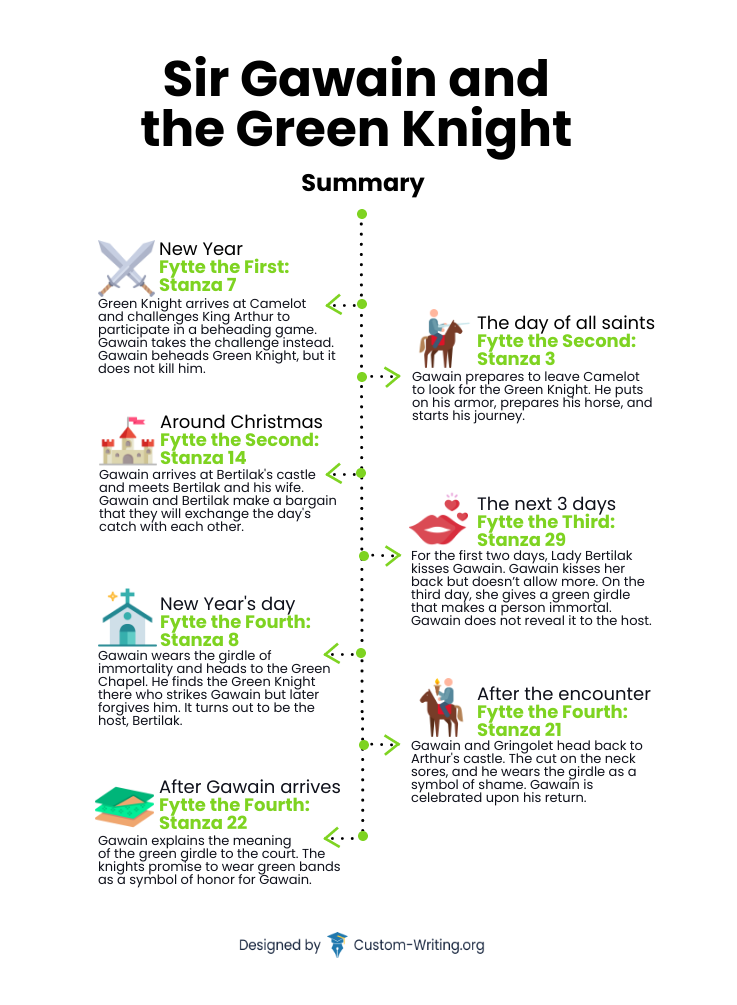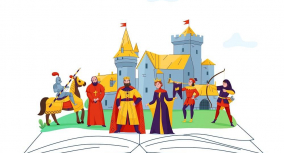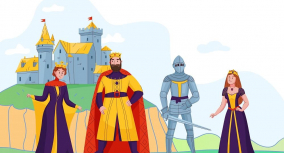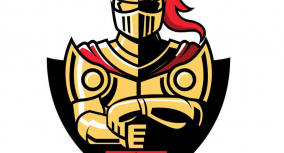The Sir Gawain and the Green Knight analysis on this page dives deep into a blend of adventure and moral questioning in medieval England. Here, our Custom-Writing experts will focus on the summary of Sir Gawain and the Green Knight and provide line-by-line annotations to clarify the poem’s themes and verses.
Read the page to discover how the noble knight’s courage and honor are tested in his encounter with the mysterious Green Knight. We’ll also examine the roles of key Sir Gawain and the Green Knight characters and the genre it represents. Whether you’re seeking a synopsis or an insightful analysis, this guide is your ultimate resource for understanding one of the greatest works in medieval literature.
Sir Gawain and the Green Knight Short Summary
The poem opens with Sir Gawain participating in the Green Knight’s bizarre beheading challenge and decapitating him. Yet, the Green Knight survives the blow. A year later, Sir Gawain embarks on a journey for the return stroke. He reaches Lord Bertilak’s castle, where a charming lady tries to seduce him and gives him a magic green girdle. Sir Gawain hides the girdle and faces the Green Knight, who turns out to be Lord Bertilak. The Green Knight spares Sir Gawain, who returns to Camelot.

Sir Gawain and the Green Knight Summary with Quotes
Part I, Lines 1-129
The poem starts with the court of King Arthur celebrating New Year’s Eve in Camelot. The opening stanza of Sir Gawain and the Green Knight story alludes to Troy’s fall and its destruction. It then tells how Trojan heroes fled to Europe to establish new civilizations in Rome and Europe. The poet says that Britain was founded by these warriors, too, and the greatest of all was Arthur.
In this domain more marvels have by men been seen
Sir Gawain, Narrator, Part I, Lines 23-26
than in any other that I know of since that olden time;
but of all that here abode in Britain as kings
ever was Arthur most honored, as I have heard men tell.
In the second stanza, the poet announces his intention of telling this Arthurian legend. The Gawain poet uses many hyperbolas and literary exaggerations to catch the reader’s attention.
In stanzas 4, 6, and 7, the Gawain poet tells about Arthur’s feast and some gift-giving games the court plays. There is an emphasis on the decoration, food, and lavish dressing of the Queen and King Arthur’s court: fine silks, the best gems, chivalric symbols, precious cloth of Toulous, and tapestry of Tarts. Arthur is described as an attentive host who would refuse to eat before others are served. The readers also learn that Arthur does not like to start his feast before hearing a lovely tale.
…it pleased him not to eat
Sir Gawain, Narrator, Part I, Lines 91-95
upon festival so fair, ere he first were apprised
of some strange story or stirring adventure,
or some moving marvel that he might believe in
of noble men, knighthood, or new adventures.
All of this creates an atmosphere of growing tension.
Part I, Lines 130-490
The celebration gets interrupted by an enormous man who is fully green entering the hall. Despite his unusual appearance, the stranger looks handsome and well-dressed. The poet describes in detail the clothing and weapon the green stranger carries with him.
All of green were they made, both garments and man:
Sir Gawain, Narrator, Part I, Lines 151-156
a coat tight and close that clung to his sides;
a rich robe above it all arrayed within
with fur finely trimmed, showing fair fringes
of handsome ermine gay, as his hood was also,
that was lifted from his locks and laid on his shoulders.
Arthur invites him to join the feast and asks him questions about the reason for his visit. Nevertheless, the visitor rejects the invitation and explains that he came to play a little game. At first, Arthur thinks that the green man talks about a duel. However, he does not want a traditional fight. He says that he will allow one knight to hit him with the ax, and a year later, the challenger will receive a hit in return.
No one wants to participate in this game, and eventually, Arthur is about to agree. To save the King and the court’s honor, Gawain decides to play the game himself instead.
From beside the queen Gawain
Sir Gawain, Gawain, Part I, Lines 339-342
to the king did then incline:
‘I implore with prayer plain
that this match should now be mine.’
Gawain takes the ax and, with one hit, takes off the head of the giant. However, the green knight does not fall. Before leaving the castle, he picks up his head and reminds him about the rules.
Part II, Lines 491-762
Next year, Gawain spends time before Christmas with Arthur and the Knights of the Round Table. Everyone tries to pretend to be happy. However, it is not easy because they don’t want to say bye to noble Gawain. After the meal, Gawain tells King Arthur and his court that he is leaving to look for the Green Knight. He puts on his best armor and leaves Camelot.
Now Gawain in brave array
Sir Gawain, Narrator, Part II, Lines 666-669
his lance at last hath caught.
He gave them all good day,
for evermore as he thought.
Throughout the journey, he encounters a lot of adventures and misfortunes. The weather is the worst of all, making him pray to the Virgin Mary (his patron saint) for shelter.
Part II, Lines 763-1125
Suddenly, he sees a white castle that looks beautiful and unreal. Its owner invites him in, a large man by the name of Lord Bertilak. He introduces Gawain to his wife, Lady Bertilak, and to an elderly lady who also lives in the castle. It is peculiar that the host is as big as the Green Knight. Gawain cannot make a connection, though.
And he thought bold and big was the baron of the castle,
Sir Gawain, Narrator, Part II, Lines 843-844
very large and long, and his life at the prime.
The atmosphere in the castle is quite friendly. The guest plays games with the host and the two ladies. The game they play after the Christmas mass is focused on giving away valuable clothing pieces one by one to those who win them by entertaining the company.
In this manner, three days pass. However, Gawain has to leave to find the Green Knight. The host begs him to stay, but Gawain refuses. When Gawain explains that he still has to find the Green Chapel, the host says that he knows where it is. Luckily, it is nearby. So, the protagonist can stay with them until New Year’s Eve. Sir Gawain agrees to this plan.
Then was Gawain delighted, and in gladness he laughed:
Sir Gawain, Gawain, Part II, Lines 1079-1082
‘Now I thank you a thousand times for this beyond all!
Now my quest is accomplished, as you crave it, I will
dwell a few days here, and else do what you order.’
The host also proposes a deal to Gawain. Since he is tired of all the travels, the host will be busy hunting, while Gawain will be spending time with the lord’s wife. In the evening, they will exchange with each other whatever they got as a prey. Sir Gawain accepts this deal as well.
Part III, Lines 1126-1997
On the first day, the lord hunts a deer, and the lady kisses Gawain. At the dinner, the men exchange what they got. The next day, the lord gives away a boar and receives two kisses from Gawain. On the third day, the lord brings home a fox, and the lady kisses Gawain three times. She tries to seduce Gawain, but he refuses to sleep with her.
The knight said: ‘By Saint John,’
Sir Gawain, Gawain, Part III, Lines 1788-1791
and softly gave a smile,
‘Nay! lover have I none,
and none will have meanwhile.’
She also demands him to give her a love token, yet, he says that he has nothing for her. Instead, the lady offers him a green girdle. She explains that it will protect the wearer from death. Gawain hides it from the lord and does not give it to him during the exchange.
Part IV, Lines 1998-2330
In the morning, Gawain leaves the castle and the lord’s family and travels to the Green Chapel to fight the Green Knight. He travels with a servant who tries to convince him not to face the giant. Gawain refuses because he does not want to be a coward.
…If I here departed
Sir Gawain, Gawain, Part IV, Lines 2129-2132
fain in fear now to flee, in the fashion thou speakest,
I should a knight coward be, I could not be excused.
Nay, I’ll fare to the Chapel, whatever chance may befall.
When they reach the chapel, the travelers can hear the honing of an ax. Gawain yells to announce that he has arrived as agreed. When the green man exits, Gawain bows to him, and the green man commends him for keeping the word. Soon, The Green Knight raises the ax, but because Gawain flinches, he stops and starts mocking Gawain for his cowardice.
Thou’rt not Gawain,’ said the green man, ‘who is so good reported,
Sir Gawain, the Green Knight, Part IV, Lines 2270-2272
who never flinched from any foes on fell or in dale;
and now thou fleest in fear, ere thou feelest a hurt!
Gawain promises not to do that again, though stating a significant difference between them. If Gawain gets beheaded, he will not survive and pick his head up because he is just a human. Gawain asks to be quick and to get it over with.
The Green Knight raises his ax once again but stops at the last second. He praises the young man for not flinching this time. The last time the Green Man raises his ax, he hits Gawain enough to cut his skin and leave a scar. Gawain jumps away and is ready to defend himself.
Part IV, Lines 2331-2478
The Green Knight tells Gawain to calm down and explains that the first blows were harmless because of his honesty during the exchange with the lord. The last one is the payment for Gawain’s secret. He says that the green belt or the girdle that he accepted from the host’s wife belonged to the host. Nevertheless, he sees that Gawain is a faithful man.
… Thou seem’st to me truly
Sir Gawain, the Green Knight, Part IV, Lines 2362-2365
the fair knight most faultless that e’er foot set on earth!
As a pearl than white pease is prized more highly,
so is Gawain, in good faith, than other gallant knights.
Gawain is ashamed and starts crying in despair. He declared himself a coward for withholding the girdle and the truth. However, the Green Knight says that Gawain is innocent in his eyes.
Gawain asks the Green Man for his name and learns that he is Bertilak, the host. He also finds out that the old lady in the castle, Morgan le Faye, arranged the whole thing out of hate for Guinevere.
She put this magic upon me to deprive you of your wits,
Sir Gawain, Gawain, Part IV, Lines 2459-2460
in hope Guinevere to hurt, that she in horror might die.
Part IV, Lines 2479-2530
Gawain returns home, and the court happily receives him. He tells the story of his journey and his disgrace as well.
It was torment to tell the truth:
Sir Gawain, Narrator, Part IV, Lines 2501-2504
in his face the blood did flame;
he groaned for grief and ruth
when he showed it, to his shame.
He refuses to remove the girdle. So, the court says they will wear one, too, as a sign of respect for Gawain’s fate and humility.
Laughed loudly thereat, and this law made in mirth
Sir Gawain, Narrator, Part IV, Lines 2514-2518
the lords and the ladies that whoso belonged to the Table,
every knight in Brotherhood, a baldric should have,
a band of bright green obliquely about him,
and this for love of that knight as a livery should wear.
Sir Gawain and the Green Knight Analysis: Verse Form
Sir Gawain and the Green Knight was written in the Middle Ages around the 14th century. It is in the Middle English variant of English, which is very close to the modern one. The poets of that period didn’t rely much on rhyme or metrical syllabic count. Instead, they preferred alliterative verse.
This type of verse includes the following scheme:
- A pair of words that alliterate at the beginning of the line.
- Another word that alliterates with the first two at the end.
- A slight pause called caesura that divides the line into two parts.
For example, here’s what one of the lines looked like:
- Original: Boþe þe barres of his belt and oþer blyþe stones.
- Translation: both the bars on his belt, and bright stones besides.
The poem has 2,530 lines and is written in alliterative verse with the repetition of “k” and “f” sounds. This alliteration run through the entire poem.
The Gawain poet also uses a metrical form called the bob and wheel, a common one for medieval texts. The wheel is a verse that occurs at the end of each stanza. The bob is a short line that announces the wheel.
For example:
On many a broad bank and brae Britain established
Sir Gawain, Narrator, Part I, Lines 14-19
full fair
where strange things, strife and sadness,
at whiles in the land did fare,
and each other grief and gladness
oft fast have followed there.
In this example, the short, two-word line “full fair” is the bob, and the following four lines are the wheel.
Genre of Sir Gawain and the Green Knight
The genre of Sir Gawain and the Green Knight is a medieval romance. What does this mean? Well, romance lies at the intersection of intersection of love narratives (of fine love or fin amor in particular) and Great Britain’s myth history.
Here are the 5 features that indicted you’re reading a classic medieval romance:
- It highlights the main character’s journey to self-discovery. The hero has to complete the quest that teaches him a lesson and changes him. In this poem, Sir Gawain goes through various tests to return to King Arthur’s court as a better version of himself.
- The characters of the medieval romance follow a strict code of conduct. The knight must keep his word, be brave, and be loyal to his lord. We can see all these qualities in the protagonist of Sir Gawain and the Green Knight.
- Courtly behavior is a crucial element of this genre. For example, Sir Gawain has excellent manners and charms everyone with his conversation. Besides, his behavior towards women is impeccable.
- King Arthur plays a prominent role in it. In fact, Arthur is a key figure in almost all major medieval romances that are known, even when he is not present as a character.
- All medieval romances stress the importance of the Trojan War. During that era, there was a belief that the British were connected to Brutus, one of the conspirators who overthrew Caesar. Therefore, Anglo-Norman tradition traces its roots to the “civilization” back to the Great Trojan War. Sir Gawain and The Green Knight starts and ends with an allusion to the Trojan War.
Analysis of Sir Gawain and the Green Knight’s Subversion
The story of Gawain is an unusual chivalric romance. Mainly because, traditionally, medieval romance legends were stories of daring deeds. It means the knight would be defeating a large group of men alone. However, in this poem, there are no battles at all. Both Sir Gawain and the Green Knight willingly kneel to take their stroke. In fact, you won’t find any violence or actual bloodshed here, as both characters are safe and sound in the end.
The protagonist in this poem faces two real struggles of a different kind:
- One is with his beautiful hostess, Lady Bertilak. In this duel, he doesn’t need a sword or armor. He fights with polite words and strong principles.
- Another battle is with himself. He struggles with his fears and desires and, as a result, loses not to the stronger adversary but to his fear of death.
Another peculiar detail is that the most popular Arthur’s knight, Lancelot, is not in the story. So, Gawain takes the leading role, being depicted as almost a saint. He is a virgin and courageous man who keeps his promise and refuses to sleep with the host’s wife.
The poem also criticizes Arthur’s court. Sir Gawain is the youngest one at the table. Yet, he is the one who accepts the challenge from the Green Knight, while other knights are portrayed as weak and boyish. Even King Arthur himself is described as childish at the poem’s beginning.
Literary Devices in Sir Gawain and the Green Knight
The story of Gawain is both powerful and complex. It has a lot of layers, themes, and symbols that can contribute to its understanding.
Point of View
The story is told from the first-person point of view. However, the narrator doesn’t play an active role in the poem. He is just a storyteller who recounts an old legend:
If you will listen to this lay but a little while now,
Sir Gawain, Narrator, Part I, Lines 30-32
I will tell it at once as in town I have heard
it told.
This technique allows the author to deliver not just the actions and thoughts of Sir Gawain but also follow other characters. For example, the narrator describes the hunting scenes of Lord Bertilak. At the same time, the story is mainly limited to Sir Gawain’s point of view, which makes the final revelations unexpected.
Tone
The tone of the poem is fantastical and includes numerous exaggerations.
Here are a few examples:
- The knights at camelot are “most renowned after the name of christ,”
- Ladies are “most lovely that ever life enjoyed,”
- The green knight is described as “the largest man alive,”
- The hall in the castle is decorated with “finest sandal,” “brightest gems,” and so on.
Sir Gawain, Lord Bertilak, Lady Bertilak, and Lord Bertilak’s castle are described with the same awe. All these overstatements make the story sound like a fairy tale.
Foreshadowing
Another literary device the author uses is foreshadowing, which means dropping various hints of what is about to happen to create suspense.
The fact that King Arthur doesn’t want to eat until he hears a strange story or “a challenger should come” who looks for a battle suggests that such a challenger is coming. The appearance of the Green Knight and Lord Bertilak, the unusual compact Sir Gawain makes with his host, and Lady Bertilak’s behavior are clues that Lord Bertilak and the Green Knight are the same person.
Thanks for reading the article! To find out about the characters, themes, and symbols in detail, check other articles. You can find essay topics and samples on Sir Gawain and the Green Knight as well.











